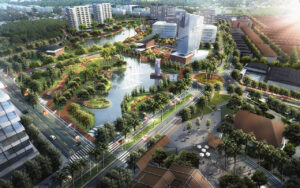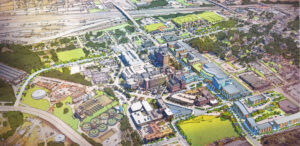Today, urbanization is rapidly progressing in many countries, particularly in developing nations. Consequently, urban design is a crucial factor in the construction and development of urban areas. It not only influences the overall structure of cities but also significantly impacts the quality of life for residents. In this article, we will explore the fundamental urban design principles that contribute to building a sustainable, safe, and friendly living environment.
Principles of Balance and Sustainability
Balance and sustainability are considered two prerequisites in urban design principles. Given that cities are long-term projects directly associated with people’s lives, achieving balance is vital.
- Balance Between Factors: Urban design must ensure a balance between natural and man-made elements. This entails planning public spaces, housing, and infrastructure in harmony with the natural environment, thereby creating a sustainable ecosystem. Green spaces, such as parks and gardens, not only enhance the city’s beauty but also provide fresh air and relaxing areas for residents, contributing to their overall happiness.

- Sustainability: Sustainability is one of the leading principles in modern urban design. Buildings must be built with sustainable materials, saving energy and limited resources such as water, oil, gas,…. Integrating solutions such as solar energy, rainwater collection or smart waste management systems is necessary to minimize negative impacts on the environment. Especially, these were problems of water pollution, soil pollution and air pollution was severe in the past.
Principles of Flexibility and Responsiveness
In the context of urban development and rapid change, the principles of flexibility and responsiveness in urban design become key factors to create sustainable living spaces. Exploring how urban design can be flexible in the face of change, we will see that creativity and adaptability are the keys to a better urban future.
- Flexibility in Planning:
Urban planning needs to be flexible to adapt to changing needs and social trends. Areas can be designed to easily change their use, from commercial to residential or vice versa. This not only helps to optimize the use of space but also maintains the vitality of the city.
- Responding to Community Needs:
Urban design should be grounded in the actual needs of the community. Engaging with residents and stakeholders is essential to ensure that designs reflect their desires and requirements. Surveys, workshops, and forums are effective tools for gathering this information. By applying these principles, designers can address challenges like climate change and population growth, while creating diverse living environments tailored to community needs.
Connectivity and Mobility Principles
The connectivity and mobility in urban design principles play an important role in creating friendly and convenient living spaces. When urban areas are designed for easy connection, residents can move smoothly and safely, enhancing their quality of life.
- Connectivity Between Areas:
A good urban area needs strong connectivity between areas. Roads, walkways and public transport systems should be designed to allow residents to easily move from one place to another. Connectivity not only helps reduce traffic congestion but also promotes local economic development.

- Diverse Transport Systems:
Urban design should incorporate various transport modes, from bicycles and buses to subways. This diversity helps reduce pollution and allows residents to choose the transportation method that best suits their needs. Optimizing transport networks and public spaces can foster social interaction and promote sustainable community development.
Safety and Comfort Principles
The safety and comfort principles in urban design are key to creating a sustainable and pleasant living environment for residents.
- User Safety:
Safety is an indispensable element in urban design. Public areas should be designed so that residents feel safe when moving around, including adequate lighting, surveillance cameras and other protective measures. When public spaces are designed with security and comfort in mind, people will feel more secure in using and interacting.
- Creating a Feeling of Comfort:
Urban environments should be designed to create a sense of comfort for users. Public spaces such as parks and squares should be arranged reasonably, with shade, seating and amenities for residents. This not only improves the quality of life but also encourages people to participate in community activities in urban events.
Principles of Shaping Culture and Community
The principles of shaping culture and community in urban design emphasize the importance of creating spaces that reflect local identity and encourage social cohesion.
- Preserving Local Culture:
Urban design must consider and preserve local cultural and historical values. Distinctive architectural works and historical relics should be protected and integrated into urban planning, thereby preserving the cultural identity of the area. By honoring cultural heritage and facilitating community activities, we can create vibrant, humane and connected cities.
- Encouraging Community Activity:
Public spaces should be designed to encourage interaction between residents. Successful urban designs not only meet functional needs but also nurture relationships between residents and their surroundings.
Principles of Smart Technology Use
The principles of smart technology use in urban design emphasize the role of technology in optimizing urban management and improving the quality of life for residents. By integrating advanced technology solutions, cities can become more efficient, more sustainable and quickly respond to community needs.

- Technology in Urban Planning:
The application of smart technology in urban design helps improve the efficiency of management and resource use. Sensor systems and big data analysis can provide useful information about residents’ needs, thereby helping planners make more accurate decisions.
- Urban Information Systems:
It is necessary to build urban information platforms so that residents can easily access information about planning, public services and activities taking place in the area. This not only increases transparency but also helps residents actively participate in urban development.
Urban design is a complex but vital process for creating a better living environment for residents. By applying urban design principles such as sustainability, flexibility, connectivity, safety, culture and technology, we can create cities that are not only beautiful in form but also bring a high quality of life for everyone. Let’s collaborate to create sustainable cities that meet today’s needs while safeguarding the environment for the future.
